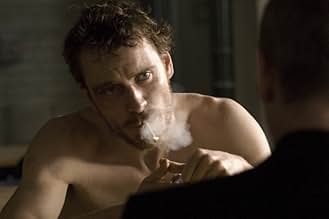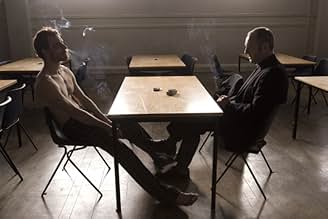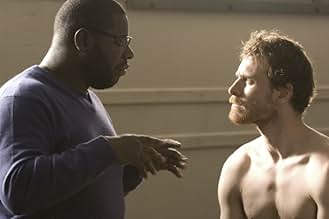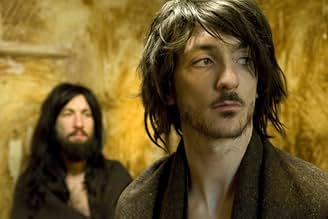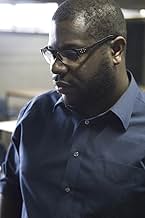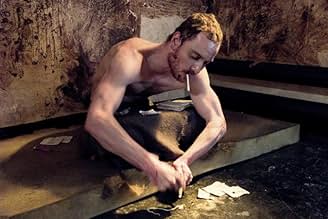Bobby Sands, un republicano irlandés lidera a los reclusos de la prisión de Irlanda del norte en una huelga de hambre.Bobby Sands, un republicano irlandés lidera a los reclusos de la prisión de Irlanda del norte en una huelga de hambre.Bobby Sands, un republicano irlandés lidera a los reclusos de la prisión de Irlanda del norte en una huelga de hambre.
- Dirección
- Guionistas
- Elenco
- Ganó 1 premio BAFTA
- 49 premios ganados y 39 nominaciones en total
- Dirección
- Guionistas
- Todo el elenco y el equipo
- Producción, taquilla y más en IMDbPro
Opiniones destacadas
Hunger is a powerful and disturbing feature-film debut for the visual artist Steve McQueen. The film takes place almost exclusively within the confines of a high-security prison in Northern Ireland, where many members of the Irish Republican Army are interned. The small confines of the prison serve as a microcosm of the wider Troubles in Ireland. The conflict between the British wardens and the Irish inmates escalates steadily, with each indignity and abuse inevitably leading to another.
The conditions revealed in the prison are deeply disturbing, with the inmates fouling the jail with effluent and the guards responding with ritual humiliation and savage beatings. McQueen's camera is an unflinching witness to the squalor and cruelty, and with the vivid imagery and forceful sounds it is almost possible to smell and feel the frightening environs of the film.
Although the focus of the film ultimately falls on Bobby Sands, the IRA member and inmate who leads a fatal hunger strike within the prison, we are not introduced to the main protagonist until a third of the way through the film. This approach works remarkably well in setting the scene for the main narrative, but it is disappointing that the different perspectives on each side are somewhat sidelined thereafter, as Sands's personal struggle takes centre stage.
The terrible squalor of the prison cells provides some of the film's most powerful images, but it is the second third of the film that is the most gripping, as Sands converses and argues with a visiting Catholic priest. An unmoving camera is trained upon these two protagonists for what must be nearly half an hour, as Sands reveals his plan for a new hunger strike and defends his methods of achieving political goals, ultimately berating what he sees as the priest's despondency and inertia. This is an utterly compelling piece of cinema.
However, at the end of this gripping conversation, the director sees fit to insert a somewhat tortured analogy as Sands recalls for the priest a defining moment of his boyhood. This is an unnecessary effort to inject conventional beauty into Sands's story, and sits awkwardly with the general tone of the film.
In the final third of the film, the hunger strike is depicted in by now characteristically brutal detail. Lead man Michael Fassbender clearly underwent a very painful regime to portray the wasting and withering of Bobby Sands in his last days. Unfortunately, amidst the impressive attention to detail, McQueen goes further in romanticising his main protagonist through a series of flashbacks to Sands's childhood. This again jars with the realistic feel of the rest of the film, and points to McQueen's obsession with Sands, which he has admitted to having had since a young age.
Although at times steering a little close to hagiography, McQueen's directorial debut is still a bold and engrossing film that cultivates an understanding for the very different people caught in up in the Troubles in Northern Ireland. It will be fascinating to see what his next project will be.
The conditions revealed in the prison are deeply disturbing, with the inmates fouling the jail with effluent and the guards responding with ritual humiliation and savage beatings. McQueen's camera is an unflinching witness to the squalor and cruelty, and with the vivid imagery and forceful sounds it is almost possible to smell and feel the frightening environs of the film.
Although the focus of the film ultimately falls on Bobby Sands, the IRA member and inmate who leads a fatal hunger strike within the prison, we are not introduced to the main protagonist until a third of the way through the film. This approach works remarkably well in setting the scene for the main narrative, but it is disappointing that the different perspectives on each side are somewhat sidelined thereafter, as Sands's personal struggle takes centre stage.
The terrible squalor of the prison cells provides some of the film's most powerful images, but it is the second third of the film that is the most gripping, as Sands converses and argues with a visiting Catholic priest. An unmoving camera is trained upon these two protagonists for what must be nearly half an hour, as Sands reveals his plan for a new hunger strike and defends his methods of achieving political goals, ultimately berating what he sees as the priest's despondency and inertia. This is an utterly compelling piece of cinema.
However, at the end of this gripping conversation, the director sees fit to insert a somewhat tortured analogy as Sands recalls for the priest a defining moment of his boyhood. This is an unnecessary effort to inject conventional beauty into Sands's story, and sits awkwardly with the general tone of the film.
In the final third of the film, the hunger strike is depicted in by now characteristically brutal detail. Lead man Michael Fassbender clearly underwent a very painful regime to portray the wasting and withering of Bobby Sands in his last days. Unfortunately, amidst the impressive attention to detail, McQueen goes further in romanticising his main protagonist through a series of flashbacks to Sands's childhood. This again jars with the realistic feel of the rest of the film, and points to McQueen's obsession with Sands, which he has admitted to having had since a young age.
Although at times steering a little close to hagiography, McQueen's directorial debut is still a bold and engrossing film that cultivates an understanding for the very different people caught in up in the Troubles in Northern Ireland. It will be fascinating to see what his next project will be.
I saw Hunger at TIFF. I heard it was a hot ticket, and pre-festival buzz was good so I was elated when I got tickets. McQueen uses very little dialogue throughout the film, instead choosing to communicate through strong visuals and raw imagery. The film is less about the politics behind the IRA conflict, and more about the suffering of the prisoners and the dehumanization of them at the hands of the guards. It is not an easy film to watch. The imagery is so strong and raw that I couldn't help but grimace during some parts. The lady sitting next to me had her hands covering her face at one point, and was visibly crying. McQueen holds nothing back. The prisoners are shown smearing excrement over their cell walls and pouring their prison food over the floor until it goes bad and are covered with bugs. McQueen demonstrates the unwillingness of the prisoners to be stripped of their dignity (by conforming to prison demands), despite being stripped of everything else. There are some very long takes with no dialogue, with a particularly long one of a prisoner cleaning himself for what seemed like forever. The atmosphere in these scenes is so visceral that one can almost feel the filth and smell the stench of the prisoners. There is also one particularly brutal scene where the guards make two lines, and each nonconforming prisoner is marched through the middle while being repeatedly beaten by batons. Afterward, one of the officers walks outside and weeps. It is then that we learn to see the guards as human; perhaps even victims trapped within a conflict with no resolution in sight.
The story of Bobby Sands takes precedent about half way into the film. The most dialogue in the films occurs during the scenes between Sands and his priest. Unfortunately the Irish accents are thick, and I found the scene hard to decipher. The final scenes in the film are tough to watch as we witness Sands' slow dissent into the throes of starvation. It is hard to imagine anyone subjecting themselves to such suffering, yet 9 other prisoners followed suit. Fassbender is very good in the role; giving us a character that is unrelenting in his choices and beliefs. He genuinely believes his suffering serves a purpose, and though some may disagree with his choices, one can't help but admire his conviction.
Hunger is an artfully done film, which is no surprise considering McQueen is a visual artist. It is visually moving and challenging piece of work. It is hard to believe that it's his first feature, and easy to understand why it won the Camera d'or, and now the Discovery award at TIFF. I would have preferred a bit more back story to the conflict (I know close to nothing of its history), but then again, choosing to put more focus on politics may have taken away from other elements of the film. Lastly, I appreciate McQueen's unwillingness to take a stand on the conflict/protest in his film. He allows the viewers to make their own judgments; he's merely here to tell the story.
The story of Bobby Sands takes precedent about half way into the film. The most dialogue in the films occurs during the scenes between Sands and his priest. Unfortunately the Irish accents are thick, and I found the scene hard to decipher. The final scenes in the film are tough to watch as we witness Sands' slow dissent into the throes of starvation. It is hard to imagine anyone subjecting themselves to such suffering, yet 9 other prisoners followed suit. Fassbender is very good in the role; giving us a character that is unrelenting in his choices and beliefs. He genuinely believes his suffering serves a purpose, and though some may disagree with his choices, one can't help but admire his conviction.
Hunger is an artfully done film, which is no surprise considering McQueen is a visual artist. It is visually moving and challenging piece of work. It is hard to believe that it's his first feature, and easy to understand why it won the Camera d'or, and now the Discovery award at TIFF. I would have preferred a bit more back story to the conflict (I know close to nothing of its history), but then again, choosing to put more focus on politics may have taken away from other elements of the film. Lastly, I appreciate McQueen's unwillingness to take a stand on the conflict/protest in his film. He allows the viewers to make their own judgments; he's merely here to tell the story.
This debut from former artist turned director Steve McQueen will leave you breathless. In its own understated way it is epic, bold, brutal and beautiful. Telling the story of the last six weeks in the life of Bobby Sands the Irish republican hunger striker the film pulls no punches in showing life inside the maze prison and what the prisoners did to try and win political status. From the outset the shots are amazing with McQueen utilising his artistic eye to bring the best out of the very cold prison environment, his attention to detail is simply stunning making every single frame fantastically watchable despite the sometimes gruesome subject matter. Also his approach of less is more adds to the atmosphere as he has shots that have no sounds or music, like the guard cleaning the corridor with its fixed camera unflinching for several minutes the only sound the eerie echoing scrubbing. Unofficially split into three the first part deals with the incarceration and subsequent no wash protests while the last deals with the hunger strikes but it's the central piece that separates which most will remember for its ability to captivate despite just being a conversation between Sands and a visiting priest. Again shot from a fixed angle and superbly lit Sands (Fassbender) explains the morality behind his decision to stop eating. The acting and the monologue will stay with you long after the films finished and cements actor Fassbender firmly in the role to the point where you start to feel for him as he begins to waste away. When the film premiered at Cannes it caused walkouts and standing ovations before walking away with the Camera d'Or for best debut and rightly so, not only is it one of the best films of the year it is one of the most powerful I've seen. Regardless of where you stand politically the message is universal and just like the circle of faeces smeared on Sands cell wall, McQueen has crafted something beautiful out of something horrible.
Hunger (2008) ****
Bobby Sand's story has been told before on screen, but never with such raw intensity and unrelenting artistry as in Hunger. The film is directed by Turner Prize winning artist Steve McQueen. While his art has often been part of the film medium, this is his first entry into feature film-making.
The film sparked both controversy and applause at this years Cannes Film Festival, with both disgusted walkouts and rousing ovation. It the end it landed McQueen the Camera D'or.
While the film follows the final weeks of Bobby Sand's hunger strike, it is equally about recreating the atmosphere and conditions inside the infamous Long Kesh Maze Prison. Its nearly a half hour into the film before we even meet Sands, in fact. We're introduced to a prison guard, who outside nervously checks his car for bombs, quietly avoids his comrades, then becomes as vicious as any other when brutalizing the inmates. We're also first introduced to a new inmate, who, as per the IRA standard, refuses to war a uniform and instead goes simply wrapped in a blanket. He and his cellmate smear the walls of their cells in feces as part of the no wash protest.
Bobby is played by Michael Fassbender, who gives a quietly powerful performance. For the film he underwent a medically supervised crash diet, one rivaling - if not outright surpassing - that of Christian Bale in the Machinist. He moves throughout the film with a sense of determination and dedication.
It is difficult to go into any detail about plot, as the film more or less moves patiently and quietly towards the inevitable. And the key word may be quiet. McQueen claimed that he originally envisioned doing the film dialogue free. Indeed, much of Hunger is free of dialogue. However, McQueen, as he puts it, felt it would be more powerful to go from vocal silence into an avalanche of dialogue. And so the films centerpiece was born - a 20 minute stationary shot of Bobby speaking with his Priest. In a film that is filled with a dark heaviness in a cruel prison atmosphere, that meeting lifts a weight for a time, before slowly descending into a sad sense of inevitability. Though that inevitability is liberating, it is nonetheless a profoundly sad one. The film also does not shy away from the cruelty of the British towards the Irish, though it also does not deny the brutality of the IRA at times - as characterized in one shocking moment. However, anyone with any inkling of rational knowledge on the Irish struggles knows that the IRA was never simply a terrorist organization, but a rebel group that did from time to time employ terrorist tactics. Like all anti-state organizations, however, the IRA did not exist for the sake of conflict, but because of callousness and cruelty. McQueen reminds us of the cruelty and arrogance of the British particularly through the cold words of Margaret Thatcher, speaking shamelessly about Sands' strike.
There have been many fantastic films about the Irish Struggles, with some of the best coming in recent years (Ken Loach's fantastic Wind that Shakes the Barley, and Paul Greengrass's Bloody Sunday, to name two of the better). This one, I think, may be the best. At least from an artistic and purely visceral standpoint. McQueen captures his scenes in jarring compositions, with all the skill and artistic imagining of a true artist. From the opening sequences, Hunger promises something more than just the standard. Whereas most political films focus all their attention on the message, Hunger focuses on the feeling, and never strays from its artistic goals. This is art, from its opening to closing frames. It's a boldly crafted and brave film. The cinematography and direction are assured, moving slowly and unexpectedly, always beautifully even in its darkest and dirtiest moments.
I believe this truly is a great masterpiece. McQueen has proved himself as a masterful artist of film-making as well with Hunger.
Bobby Sand's story has been told before on screen, but never with such raw intensity and unrelenting artistry as in Hunger. The film is directed by Turner Prize winning artist Steve McQueen. While his art has often been part of the film medium, this is his first entry into feature film-making.
The film sparked both controversy and applause at this years Cannes Film Festival, with both disgusted walkouts and rousing ovation. It the end it landed McQueen the Camera D'or.
While the film follows the final weeks of Bobby Sand's hunger strike, it is equally about recreating the atmosphere and conditions inside the infamous Long Kesh Maze Prison. Its nearly a half hour into the film before we even meet Sands, in fact. We're introduced to a prison guard, who outside nervously checks his car for bombs, quietly avoids his comrades, then becomes as vicious as any other when brutalizing the inmates. We're also first introduced to a new inmate, who, as per the IRA standard, refuses to war a uniform and instead goes simply wrapped in a blanket. He and his cellmate smear the walls of their cells in feces as part of the no wash protest.
Bobby is played by Michael Fassbender, who gives a quietly powerful performance. For the film he underwent a medically supervised crash diet, one rivaling - if not outright surpassing - that of Christian Bale in the Machinist. He moves throughout the film with a sense of determination and dedication.
It is difficult to go into any detail about plot, as the film more or less moves patiently and quietly towards the inevitable. And the key word may be quiet. McQueen claimed that he originally envisioned doing the film dialogue free. Indeed, much of Hunger is free of dialogue. However, McQueen, as he puts it, felt it would be more powerful to go from vocal silence into an avalanche of dialogue. And so the films centerpiece was born - a 20 minute stationary shot of Bobby speaking with his Priest. In a film that is filled with a dark heaviness in a cruel prison atmosphere, that meeting lifts a weight for a time, before slowly descending into a sad sense of inevitability. Though that inevitability is liberating, it is nonetheless a profoundly sad one. The film also does not shy away from the cruelty of the British towards the Irish, though it also does not deny the brutality of the IRA at times - as characterized in one shocking moment. However, anyone with any inkling of rational knowledge on the Irish struggles knows that the IRA was never simply a terrorist organization, but a rebel group that did from time to time employ terrorist tactics. Like all anti-state organizations, however, the IRA did not exist for the sake of conflict, but because of callousness and cruelty. McQueen reminds us of the cruelty and arrogance of the British particularly through the cold words of Margaret Thatcher, speaking shamelessly about Sands' strike.
There have been many fantastic films about the Irish Struggles, with some of the best coming in recent years (Ken Loach's fantastic Wind that Shakes the Barley, and Paul Greengrass's Bloody Sunday, to name two of the better). This one, I think, may be the best. At least from an artistic and purely visceral standpoint. McQueen captures his scenes in jarring compositions, with all the skill and artistic imagining of a true artist. From the opening sequences, Hunger promises something more than just the standard. Whereas most political films focus all their attention on the message, Hunger focuses on the feeling, and never strays from its artistic goals. This is art, from its opening to closing frames. It's a boldly crafted and brave film. The cinematography and direction are assured, moving slowly and unexpectedly, always beautifully even in its darkest and dirtiest moments.
I believe this truly is a great masterpiece. McQueen has proved himself as a masterful artist of film-making as well with Hunger.
Hunger is a low budget film from a production company more recognisable for its TV work, without any recognisable stars, without a really big distributer to get it around and directed by a Turner Prize winning visual artist making his film debut. Already you would perhaps be considering giving it a miss and maybe this isn't the best time to mention it is a largely dialogue free account of hunger-striker Bobby Sands set entirely in Northern Ireland's infamous Maze prison. This is probably one of the reasons that the film hasn't been as widely seen as it deserves to be or why audiences haven't flocked into screenings of it on a Saturday night. Certainly it is not an easy watch given the subject matter alone but yet it is a compelling and quite brilliant film.
Although the nature of the story leads the viewer to be emotionally invested in one "side" of the situation, McQueen never does anything that opens his film to this suggestion of bias or of scoring political points, if anything his attention to the detail of the tightly focused story does just the opposite. As well as telling us how many hunger strikers died, he point out how many prison guards were murdered during the period and, in my favourite part, introduces us to the prison via one guard soothing his hands (which tells us the frequency of what he does). It is a nice moment but not as telling as the thrill the viewer gets as he checks for bombs and starts his car we are supposed to be on the edge of our seat and we are, swiftly followed by the realisation that this is an experience we would repeat if we were in his driveway the next day or the next.
From here we move into a nearly dialogue free thirty minute opening where no central character really comes forward and our "focus" is on life in the prison for guards and prisoners a story that almost starts without there being a "story". The film later brings Bobby Sands to the fore, delivering one impressive dialogue scene before returning to a dialogue-light charting of his hunger strike on the way to the conclusion that we all know is coming. Yet it manages to be really engaging because of the level of each detail in each scene and the relevance of each scene to the overall film. The scene that has gotten all the mentions and praise is the long dialogue scene between Sands and the priest who comes to see him before his strike. Filmed in three distinct shots, the scene is technically impressive but also allows the main dialogue delivery of the film and the only really moment where anyone is allowed to debate and discuss the actions. Even here McQueen does not allow sides to be taken but keeps it as two men talking. It is engaging, really well written and of course, really well acted.
It is ironic that in this scene the film sits still for ages and allows the frame to remain the same because for the majority of the film McQueen's camera is the star. So many shots are striking that it almost becomes "normal" to be transfixed by an image on the screen. Whether it be a excrement-smeared cell, urine flowing down a hall or a man washing blood from his hands, it looks great and the care taken to construct each image fills the "gap" that the dialogue leaves. The performances are mostly very good and compliment the "few words" approach by bringing a lot when required and wearing their characters convincingly. There are some you may recognise but I didn't. Fassbender is the most memorable as he has the biggest character and the most startling journey, but this should not take away from smaller turns from Graham, Mullen and a few others who are also good. The film is not perfect though. The uninitiated may struggle to understand the bigger picture as you don't get a lot of help with that and those that don't get into the telling initially may be left cold by the approach. However these "weaknesses" are not missed targets or failings but rather the "cons" that have to come with the overwhelming pros of the manner of delivery.
Hunger is not an easy film to watch but it is a great film. It is wonderfully shot with an artist's composure but McQueen is not a "visual style" director who doesn't come with anything else (list your own failed music video director turned film director here) but rather he uses this approach to improve the film and make the telling better. The acting is impressive because of how real they feel and how little dialogue they have across the whole film, but to me the real star was McQueen. He is a visual artist and it shows as he makes the majority of his shots striking and engaging, even if they are not "beautiful". It may get a bit more exposure due to awards chatter but even if it doesn't it is certainly worth checking out.
Although the nature of the story leads the viewer to be emotionally invested in one "side" of the situation, McQueen never does anything that opens his film to this suggestion of bias or of scoring political points, if anything his attention to the detail of the tightly focused story does just the opposite. As well as telling us how many hunger strikers died, he point out how many prison guards were murdered during the period and, in my favourite part, introduces us to the prison via one guard soothing his hands (which tells us the frequency of what he does). It is a nice moment but not as telling as the thrill the viewer gets as he checks for bombs and starts his car we are supposed to be on the edge of our seat and we are, swiftly followed by the realisation that this is an experience we would repeat if we were in his driveway the next day or the next.
From here we move into a nearly dialogue free thirty minute opening where no central character really comes forward and our "focus" is on life in the prison for guards and prisoners a story that almost starts without there being a "story". The film later brings Bobby Sands to the fore, delivering one impressive dialogue scene before returning to a dialogue-light charting of his hunger strike on the way to the conclusion that we all know is coming. Yet it manages to be really engaging because of the level of each detail in each scene and the relevance of each scene to the overall film. The scene that has gotten all the mentions and praise is the long dialogue scene between Sands and the priest who comes to see him before his strike. Filmed in three distinct shots, the scene is technically impressive but also allows the main dialogue delivery of the film and the only really moment where anyone is allowed to debate and discuss the actions. Even here McQueen does not allow sides to be taken but keeps it as two men talking. It is engaging, really well written and of course, really well acted.
It is ironic that in this scene the film sits still for ages and allows the frame to remain the same because for the majority of the film McQueen's camera is the star. So many shots are striking that it almost becomes "normal" to be transfixed by an image on the screen. Whether it be a excrement-smeared cell, urine flowing down a hall or a man washing blood from his hands, it looks great and the care taken to construct each image fills the "gap" that the dialogue leaves. The performances are mostly very good and compliment the "few words" approach by bringing a lot when required and wearing their characters convincingly. There are some you may recognise but I didn't. Fassbender is the most memorable as he has the biggest character and the most startling journey, but this should not take away from smaller turns from Graham, Mullen and a few others who are also good. The film is not perfect though. The uninitiated may struggle to understand the bigger picture as you don't get a lot of help with that and those that don't get into the telling initially may be left cold by the approach. However these "weaknesses" are not missed targets or failings but rather the "cons" that have to come with the overwhelming pros of the manner of delivery.
Hunger is not an easy film to watch but it is a great film. It is wonderfully shot with an artist's composure but McQueen is not a "visual style" director who doesn't come with anything else (list your own failed music video director turned film director here) but rather he uses this approach to improve the film and make the telling better. The acting is impressive because of how real they feel and how little dialogue they have across the whole film, but to me the real star was McQueen. He is a visual artist and it shows as he makes the majority of his shots striking and engaging, even if they are not "beautiful". It may get a bit more exposure due to awards chatter but even if it doesn't it is certainly worth checking out.
¿Sabías que…?
- TriviaHunger is known for its unbroken 17 minute 10 second continuous shot, in which Catholic priest Father Dominic Moran tries to talk Bobby Sands out of the Hunger Strike he and his fellow 75 IRA members plan to start. The camera remains in the same position throughout the scene. To prepare, Liam Cunningham moved into Michael Fassbender's apartment, and they rehearsed the scene 12-15 times per day. On the first day of filming, the actors got it perfect after 4 takes.
- ErroresThatcher's speech that says "the men of violence have chosen in recent months to play what may well be their last card" is shown in the film when the hunger strike is beginning, but it was actually made after Bobby Sands had died. It was made on 28th May 1981. Bobby Sands died on 5th May 1981.
- Citas
Bobby Sands: I have my belief, and in all its simplicity that is the most powerful thing.
- ConexionesFeatured in Front Row: Michael Fassbender/Kate Winslet (2017)
- Bandas sonorasIndustry
Performed by Maya Beiser
Composed by Michael Gordon
Published by Red Poppy in association with G. Schirmir, Inc.
Selecciones populares
Inicia sesión para calificar y agrega a la lista de videos para obtener recomendaciones personalizadas
Detalles
- Fecha de lanzamiento
- Países de origen
- Sitio oficial
- Idiomas
- También se conoce como
- Tù Khổ Sai
- Locaciones de filmación
- Productoras
- Ver más créditos de la compañía en IMDbPro
Taquilla
- Presupuesto
- GBP 1,500,000 (estimado)
- Total en EE. UU. y Canadá
- USD 154,084
- Fin de semana de estreno en EE. UU. y Canadá
- USD 1,980
- 7 dic 2008
- Total a nivel mundial
- USD 3,185,113
- Tiempo de ejecución1 hora 36 minutos
- Color
- Mezcla de sonido
- Relación de aspecto
- 2.35 : 1
Contribuir a esta página
Sugiere una edición o agrega el contenido que falta

Principales brechas de datos
By what name was Hunger (2008) officially released in India in Hindi?
Responda



